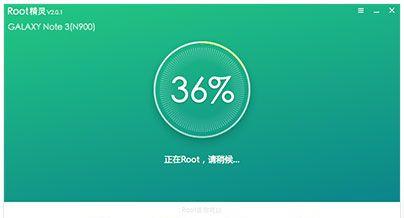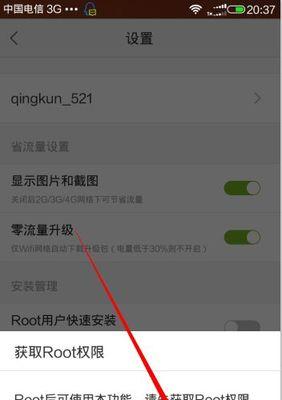 Mobile Tutorial
Mobile Tutorial
 Android Phone
Android Phone
 How to obtain root permissions for an Android device (simple and effective methods and precautions)
How to obtain root permissions for an Android device (simple and effective methods and precautions)
How to obtain root permissions for an Android device (simple and effective methods and precautions)
The editor of php Apple will share with you today the methods and precautions on how to obtain root permissions for Android devices. For some users who want to deeply customize and optimize their Android devices, obtaining root permissions is an essential step. By obtaining root privileges, users can gain complete control over the system, and can then delete pre-installed applications, modify system settings, install third-party ROMs, etc. However, obtaining root privileges also requires careful operation. Improper operation may result in device damage or loss of warranty. In this article, we will introduce some simple and effective methods to obtain root privileges, and provide some precautions to help you complete the process smoothly.

1. Introduction to the root permissions of Android devices

is equivalent to the administrator permissions on a computer, and the root permissions of Android devices Root authority refers to the authority for a user to have complete control over the system. Uninstall pre-installed applications to achieve higher-level customization operations. By obtaining root permissions, users can modify system files.
2. The necessity of obtaining root permissions
Flashing tools and applications and obtaining root permissions can unlock the potential of the phone and allow users to install various custom ROMs. It can also optimize device performance, achieve more personalized customization, and delete unnecessary system applications.

3. Understand device compatibility and risk assessment
Users need to understand their device compatibility and conduct related risks before trying to obtain root permissions. Evaluate. Moreover, obtaining root permissions may cause the device to lose its warranty or reduce its security. Different devices may have different root methods and tools.
4. Use third-party tools for root
Such as KingRoot, Magisk, etc. By using some third-party tools, users can obtain root privileges relatively easily. Users can complete the root process with simple operations, and these tools usually provide one-click root functionality.
5. Flashing the ZIP package with root permissions
Users can obtain root permissions by flashing this package. Flashing the ZIP package with root permissions is a common root method. And enter the flash mode of the device to operate. This requires the user to download the correct ZIP package in advance.
6. Use the ADB command to obtain root permissions
Users can obtain root permissions through the ADB command. AndroidDebugBridge (ADB) is a common tool for communicating with Android devices. And enable USB debugging on the device, which requires the ADB tool to be installed on the computer.
7. Device unlocking and official authorization methods
Allows users to obtain root privileges. Some device manufacturers provide official unlocking and authorization methods. For specific unlocking and authorization methods, users can search the official website or contact the device manufacturer.
8. Note: Back up important data
To prevent accidents, users should back up important personal data before obtaining root privileges. So backups are crucial, and gaining root access may cause problems with your device or data loss.
9. Note: Understand the risks and warranty issues
and may cause the device to lose warranty. Obtaining root permissions may result in reduced device security. Users need to fully understand the potential risks and device warranty policies before attempting to gain root access.
10. Note: Use trusted sources and tools
Users should use trusted sources and tools to operate when obtaining root privileges. To protect your device from viruses or malware, use unsolicited tools, or download files from unknown sources.
11. Methods and steps to remove root permissions
Users may need to remove root permissions from their devices in some cases. To help users return to a non-root state, this paragraph will introduce some common methods and steps to remove root permissions.
12. Recommended applications and functions after root
Users can install some applications and functions that are only applicable to rooted devices after obtaining root permissions. Such as TitaniumBackup, this paragraph will introduce some recommended post-root applications and functions, Greenify, etc.
13. FAQ: System upgrade after root
You may encounter system upgrade problems after the user obtains root permissions. And provide solutions and suggestions. This paragraph will answer some common post-root system upgrade questions.
14. FAQ: Application permission management after root
Users can manage application permissions in more detail after obtaining root permissions. For example, how to revoke the root permission of an application, etc. This paragraph will answer some common questions related to application permission management after root.
15.
At the same time, you need to pay attention to backing up important data and using trusted tools. Obtaining root permissions for Android devices may require users to conduct some risk assessment and full understanding. Users can enjoy more customization and personalized operations, but they also need to pay attention to possible security and warranty issues after obtaining root permissions.
Readers can learn about the methods and precautions for obtaining root permissions for Android devices, through the introduction of this article, as well as some recommended applications and methods to solve common problems after obtaining them. Hope it helps readers better utilize the potential of Android devices.
The above is the detailed content of How to obtain root permissions for an Android device (simple and effective methods and precautions). For more information, please follow other related articles on the PHP Chinese website!

Hot AI Tools

Undresser.AI Undress
AI-powered app for creating realistic nude photos

AI Clothes Remover
Online AI tool for removing clothes from photos.

Undress AI Tool
Undress images for free

Clothoff.io
AI clothes remover

AI Hentai Generator
Generate AI Hentai for free.

Hot Article

Hot Tools

Notepad++7.3.1
Easy-to-use and free code editor

SublimeText3 Chinese version
Chinese version, very easy to use

Zend Studio 13.0.1
Powerful PHP integrated development environment

Dreamweaver CS6
Visual web development tools

SublimeText3 Mac version
God-level code editing software (SublimeText3)

Hot Topics
 How to deactivate the safety mode of oppo mobile phones (quickly and easily deactivate the safety mode of oppo mobile phones)
Sep 02, 2024 pm 03:38 PM
How to deactivate the safety mode of oppo mobile phones (quickly and easily deactivate the safety mode of oppo mobile phones)
Sep 02, 2024 pm 03:38 PM
In some cases, your Oppo phone may enter safe mode, resulting in the inability to use the phone's functions normally. In this situation, you may feel confused and anxious. However, don't worry! This article will introduce you to some quick and easy methods to disable the safe mode of your Oppo phone and let you use your phone again. 1. Check the battery power If the battery power of your OPPO phone is too low, it may cause the phone to automatically enter safe mode. Please make sure your phone is fully charged and try restarting your phone. Press and hold the power button In some cases, OPPO phones can exit safe mode by long pressing the power button. Try holding down the power button for a few seconds to see if you can exit safe mode. Check the volume keys Sometimes, pressing the wrong combination of volume keys will also
 Steps and precautions for registering a Hong Kong Apple ID (enjoy the unique advantages of the Hong Kong Apple Store)
Sep 02, 2024 pm 03:47 PM
Steps and precautions for registering a Hong Kong Apple ID (enjoy the unique advantages of the Hong Kong Apple Store)
Sep 02, 2024 pm 03:47 PM
Apple's products and services have always been loved by users around the world. Registering a Hong Kong Apple ID will bring more convenience and privileges to users. Let’s take a look at the steps to register a Hong Kong Apple ID and what you need to pay attention to. How to register a Hong Kong Apple ID When using Apple devices, many applications and functions require using Apple ID to log in. If you want to download applications from Hong Kong or enjoy the preferential content of the Hong Kong AppStore, it is very necessary to register a Hong Kong Apple ID. This article will detail the steps on how to register a Hong Kong Apple ID and what you need to pay attention to. Steps: Select language and region: Find the "Settings" option on your Apple device and enter
 Solution to the problem of blurry screen on Samsung monitor (how to deal with the phenomenon of blurry screen on Samsung monitor)
Sep 04, 2024 pm 01:32 PM
Solution to the problem of blurry screen on Samsung monitor (how to deal with the phenomenon of blurry screen on Samsung monitor)
Sep 04, 2024 pm 01:32 PM
With the continuous development of technology, monitors have become an indispensable part of people's daily life and work. However, sometimes we may encounter some problems, such as screen blur on Samsung monitors. This article will introduce some common solutions to help you better deal with this problem. 1. Check whether the connection cable is secure - make sure the VGA, DVI or HDMI cables are intact and firmly connected to the monitor and computer or other devices. - Check whether the interface of the connecting cable is loose or dirty, and clean or replace it if necessary. 2. Adjust resolution and refresh rate - Adjust the resolution and refresh rate of the monitor on your computer system to ensure it matches the monitor's default settings. - Try different settings to see if they can resolve the blurry screen issue.
 How to identify genuine and fake shoe boxes of Nike shoes (master one trick to easily identify them)
Sep 02, 2024 pm 04:11 PM
How to identify genuine and fake shoe boxes of Nike shoes (master one trick to easily identify them)
Sep 02, 2024 pm 04:11 PM
As a world-renowned sports brand, Nike's shoes have attracted much attention. However, there are also a large number of counterfeit products on the market, including fake Nike shoe boxes. Distinguishing genuine shoe boxes from fake ones is crucial to protecting the rights and interests of consumers. This article will provide you with some simple and effective methods to help you distinguish between real and fake shoe boxes. 1: Outer packaging title By observing the outer packaging of Nike shoe boxes, you can find many subtle differences. Genuine Nike shoe boxes usually have high-quality paper materials that are smooth to the touch and have no obvious pungent smell. The fonts and logos on authentic shoe boxes are usually clear and detailed, and there are no blurs or color inconsistencies. 2: LOGO hot stamping title. The LOGO on Nike shoe boxes is usually hot stamping. The hot stamping part on the genuine shoe box will show
 How to safely import SEI tokens into a wallet?
Sep 26, 2024 pm 10:27 PM
How to safely import SEI tokens into a wallet?
Sep 26, 2024 pm 10:27 PM
To safely import SEI tokens into your wallet: select a secure wallet (e.g. Ledger, MetaMask); create or restore wallet and enable security measures; add SEI tokens (contract address: 0x0e1eDEF440220B274c54e376882245A75597063D); send SEI tokens to wallet address; confirm Transaction successful and check balance.
 How to clean colored silicone mobile phone cases (simple and practical cleaning tips and precautions)
Sep 02, 2024 pm 04:09 PM
How to clean colored silicone mobile phone cases (simple and practical cleaning tips and precautions)
Sep 02, 2024 pm 04:09 PM
Colored silicone phone cases are one of the common accessories for modern mobile phone enthusiasts. However, after a period of use, dirt and dust will inevitably accumulate on the phone case, affecting its appearance and hygiene. How to properly clean colored silicone phone cases is something every mobile phone user should know. This article will introduce you to some simple and practical cleaning tips and precautions to help you clean colored silicone phone cases easily. 1. Preparation before cleaning Before cleaning, first make sure that the phone is turned off and separate the phone from the phone case. Then prepare the following tools: a soft-bristled brush, mild detergent, warm water, and a clean towel. 2. Use a soft-bristled brush to remove most of the dust. Use a soft-bristled brush to gently brush off most of the dust on the surface of the colored silicone phone case. You can place the phone case on a paper towel to prevent the dust from scattering. want
 gateio exchange app old version gateio exchange app old version download channel
Mar 04, 2025 pm 11:36 PM
gateio exchange app old version gateio exchange app old version download channel
Mar 04, 2025 pm 11:36 PM
Gateio Exchange app download channels for old versions, covering official, third-party application markets, forum communities and other channels. It also provides download precautions to help you easily obtain old versions and solve the problems of discomfort in using new versions or device compatibility.
 How to check WiFi password on Android phone (simple operation allows you to easily obtain the password of the connected WiFi)
Sep 02, 2024 pm 05:10 PM
How to check WiFi password on Android phone (simple operation allows you to easily obtain the password of the connected WiFi)
Sep 02, 2024 pm 05:10 PM
With the popularity of wireless networks, we often connect to different WiFi networks, but sometimes we forget the password of a certain WiFi network. This article will introduce how to check the password of the connected WiFi on an Android phone, so that you can easily obtain and record it. Paragraph 1. Enter the WiFi settings page through system settings. Enter the WiFi settings page by clicking the "WiFi" option in the phone settings. 2. Select the connected WiFi network. In the WiFi settings page, find and click the name of the connected WiFi network. 3. Enter the WiFi network details page. In the pop-up window, click "Network Details" or similar options to enter the WiFi network details page. 4. Display the high speed of the connected WiFi





